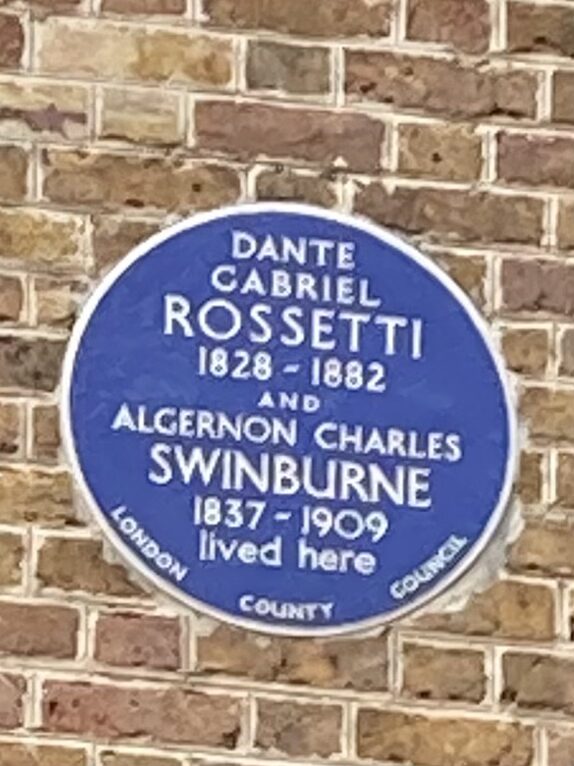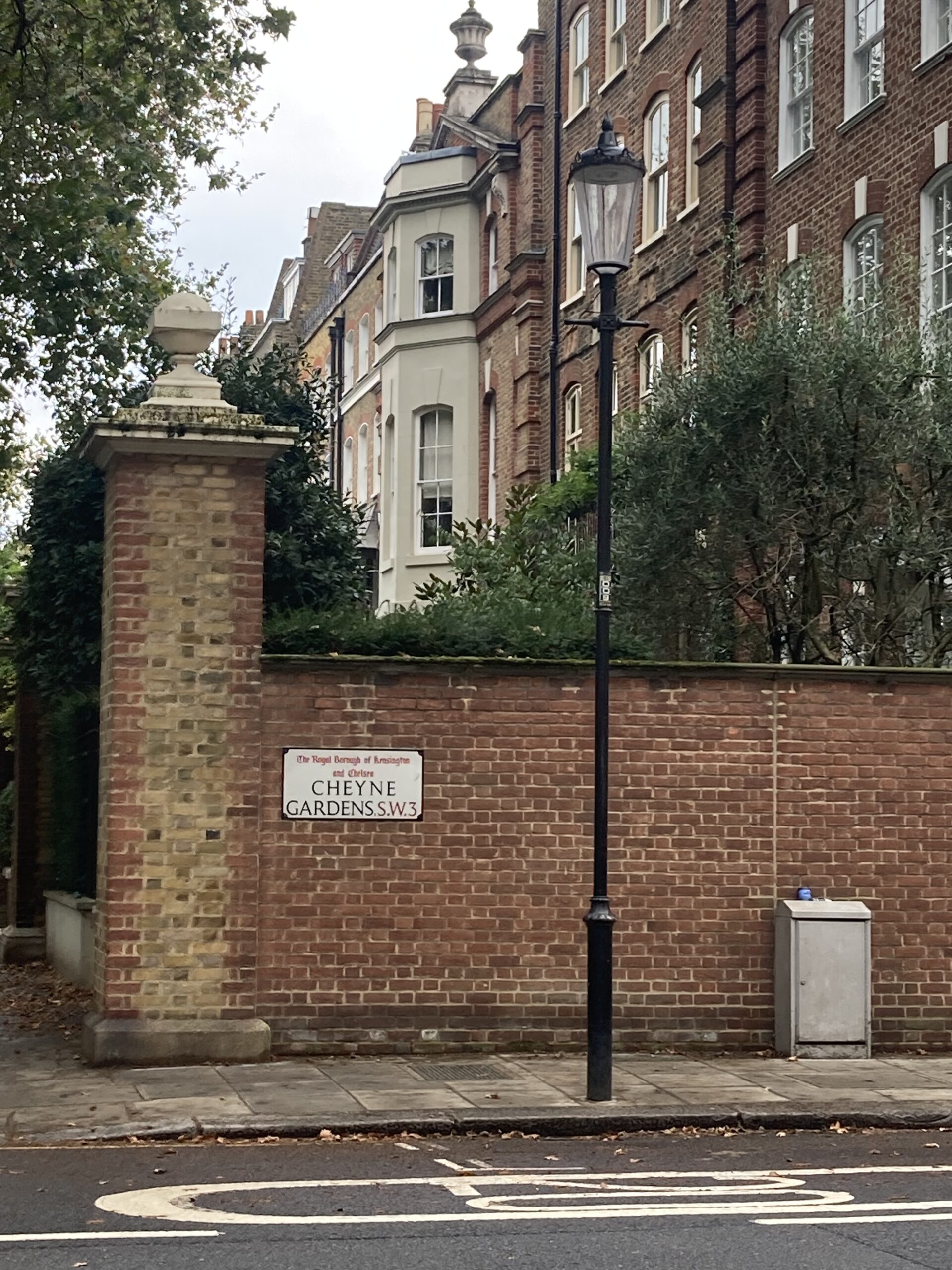by Stephanie Chatfield
Tudor House
Number 16, Cheyne Walk, Chelsea
Tudor House was Dante Gabriel Rossetti’s home from 1862 until his death in 1882. Located at 16 Cheyne Walk, Chelsea, London, this picturesque and atmospheric house became both his personal sanctuary and a hub of Pre-Raphaelite creativity and bohemian eccentricity.
The house itself
- A 17th-century, red-brick mansion, Tudor House had a fascinatingly gloomy and romantic character, perfectly suiting Rossetti’s artistic and melancholic sensibilities.
- Its riverside location along the Thames gave it a secluded, almost dreamlike feel, making it the ideal retreat for Rossetti’s increasingly reclusive lifestyle.
- The house was lavishly decorated with antique furniture, stained glass, and exotic artifacts, creating an atmospheric, medieval-inspired interior that reflected his aesthetic tastes.
- The menagerie
Rossetti famously filled Tudor House with exotic animals, turning it into a Victorian menagerie.
His collection included: Two wombats (one named Top became his favorite and was even buried in the garden).
Owls, peacocks, armadillos, kangaroos, and other eccentric creatures.
The animals often wandered freely through the house, adding to its surreal and chaotic charm. (Although, I do wonder how he dealt with the smell!)
My husband and I walked to Rossetti’s home on a drizzly day in 2023. The neighborhood was quiet and we spent a peaceful afternoon soaking in the atmosphere.












“I was ushered into one of the prettiest and most curiously furnished old-fashioned parlours that I had ever seen. Mirrors and looking-glasses of all shapes, sizes and design lined the walls. Whichever way I looked I saw myself gazing at myself.” Recollections of Dante Gabriel Rossetti and his circle (Cheyne walk life), Henry Treffry Dunn
Henry Treffry Dunn, who was at one time Rossetti’s studio assistant, gives us an intimate glimpse into the artist’s home. Rossetti moved into Tudor House soon after the death of his wife, Elizabeth Siddal, from an overdose of laudanum.
Antics in the home
Rossetti’s years at Tudor House are often described as bohemian and his behavior in that time became quite eccentric. It was in this home that he began collecting his menagerie of exotic animals and developed a passion for hoarding antique furniture, blue-and-white china, and vast amounts of bric-a-brac. His former lover and model Fanny Cornforth became the housekeeper of Tudor House and the household also consisted of poet Algernon Charles Swinburne.

It was an almost all male existence at Tudor House and it does not seem to have been a haven of peace. Artist James MacNeil Whistler, who lived nearby, visited often. One morning the excitable Swinburne flung an egg in the face of novelist George Meredith during a disagreement about author Victor Hugo.
Apparently Meredith didn’t fare well at Rossetti’s house at all, since poet Wilfred Scawen Blunt’s diary also describes Rossetti throwing a cup of tea in Meredith’s face in a similar argument.
Visitors were reportedly disgusted by Rossetti’s large breakfasts; Hall Caine wrote that Rossetti ate six eggs and half a dozen kidneys.
A story also persist about Swinburne sliding down the banister naked. In the midst of all of this ribald behavior, there were elements of sadness. Rossetti’s displayed his late wife’s art in the drawing room, as mentioned by Georgiana Burne-Jones in her biography of her husband, artist Sir Edward Burne-Jones.
“No Thames Embankment had reached Chelsea then, and only a narrow road lay between the tall iron gates of the forecourt of 16, Cheyne Walk, and the wide river which was lit up that evening by a full moon. Gabriel had hung Lizzie’s beautiful pen-and-ink and water-colour designs in the long drawing-room with its seven windows looking south, where if ever a ghost returned to earth hers must have come to seek him: but we did not sit in that room, the studio was the centre of the house.”

In Recollections of Dante Gabriel Rossetti and his circle, Dunn states that the mantelpiece seen on the far right was an “original make-up of Chinese black-lacquered panels bearing designs of birds, animals, flowers and fruit in gold relief.” Blue Dutch tiles decorated each side of the fireplace. In addition to the mirrors Dunn mentioned at the beginning of this post, we can also see Rossetti’s portraits of his mother and sister on the wall. On the left is the portrait of Rossetti’s mother Francis Polidori Rossetti with his sister Christina. On the far right is his portrait of Christina, author of Goblin Market.



“When the party was an exceptional one, I mean for the number of friends invited, the table was laid in the so-called drawing room — an apartment comprising the whole width of the house, boasting of five windows giving an extensive and interesting view of Chelsea reach…”

Although Dunn says five windows, I do believe this is the same seven-windowed room mentioned by Georgiana Burne-Jones that contains Elizabeth Siddal’s art.

Dunn gives us a look at Rossetti’s bedroom as seen through a mirror. His description of the bedroom sounds oppressive and claustrophobic: “I thought it a most unhealthy place to sleep in. Thick curtains heavy with crewel work in designs of print and foliage hung closely drawn round an antiquated four-post bedstead.”
In fact, Rossetti’s bedroom sounds exactly as I imagined it would, as Dunn also mentions it is cluttered and filled with ‘Chinese monstrosities in bronze’, blue china vases filled with peacock feathers, lots of shelves filled with brass repousse’ dishes and that the only modern thing in the room was a box of matches.
Stories from Tudor House have added to Rossetti’s eccentric reputation, this is the Rossetti we see as a mad collector of animals, the bohemian artist living with the decadent Swinburne. It all seems a bit wild and lascivious, but though he may seem a crazy libertine, I see hints of sadness.
As much as it was a house of frivolity, it was also the house in which Rossetti experienced deep depression and paranoia. It was during this time when his obsession for Jane Morris reached its pinnacle, for Rossetti was the kind of artist who desperately needed a muse. Which brings me to another of Dunn’s representations of Tudor House. Rossetti’s Studio. We can see several works depicting Jane Morris, notably Proserpine at the right.


Tudor House, with its red-brick façade and riverside charm, remains a landmark associated with Dante Gabriel Rossetti and the Pre-Raphaelite Brotherhood. Though it is now a private residence, its mythical status in Pre-Raphaelite lore endures.
Index of Adventures
- A Pre-Raphaelite Look at Hitchcock’s Vertigo
- Balancing on the Bridge
- From Tennyson to TikTok: Are We All Living the Lady of Shalott’s Curse?
- On Storms
- Paul McCartney, Photographs 1963–64: Eyes of the Storm
- Peter Pan in Kensington Gardens
- Pre-Raphaelite Princess of Star Wars
- St. Pancras Old Church Gardens
- The Magic Down the Rabbit Hole
- The Wounded Dove
- Unconventional Beauty
- Visiting Lizzie Siddal at Highgate Cemetery
- Westminster Abbey
- What Grows from Grief












